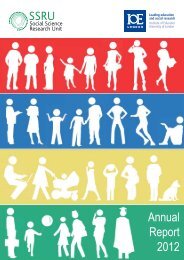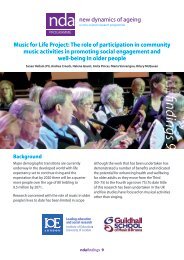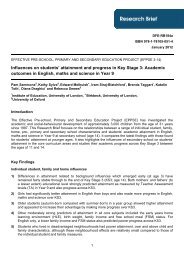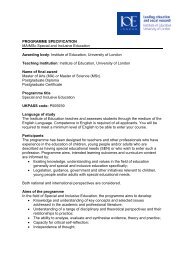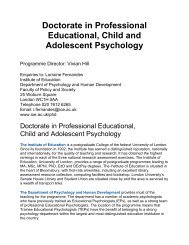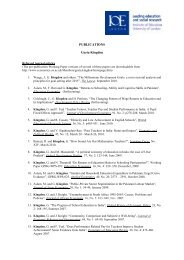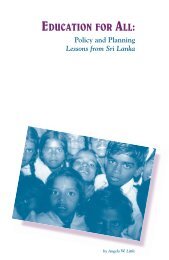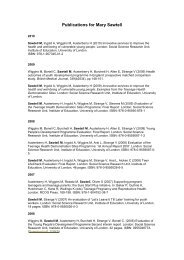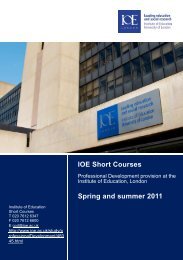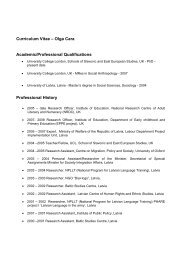Working paper 1 (pdf - Institute of Education, University of London
Working paper 1 (pdf - Institute of Education, University of London
Working paper 1 (pdf - Institute of Education, University of London
Create successful ePaper yourself
Turn your PDF publications into a flip-book with our unique Google optimized e-Paper software.
He also describes how mothers come to the school asking for food and emphasizes the greater<br />
involvement <strong>of</strong> mothers in the school. For example, he notes:<br />
And then the people that are attending the meetings mostly, during the parents meeting, are<br />
the female ones. They are dominating actually, so they are the ones who are making the<br />
school to survive.<br />
Researchers in Kenya noted that that it was mostly mothers who accompanied children into the<br />
school when they had discipline problems suggesting that involvement in education may be seen as<br />
an aspect <strong>of</strong> care work carried out by women. These connections <strong>of</strong> mothers to the school point to<br />
particular area where there appears potential to build closer links between the poor community and<br />
the school and to use this as a basis to examine ideas about gender inequalities and how to change<br />
these.<br />
But currently the dynamic to work with parents who are coming into school and showing interest in<br />
their children‟s education appears stalled. In both school settings the blaming poor parents sits quite<br />
comfortably with viewing existing initiatives to ameliorate poverty primarily as charity. In Kenya the<br />
revival <strong>of</strong> a school feeding scheme is cited by many as important to address the problem <strong>of</strong> pupil<br />
hunger, but this important aim does go further in requirements <strong>of</strong> the community or the government.<br />
In South Africa the importance <strong>of</strong> the school feeding scheme is emphasized by the headmaster who<br />
explains how, in addition to the provincial scheme, they have someone to provide them with bread<br />
twice a week and also talks about giving food to “certain families” – helping the parents as well as the<br />
children. They have also got taxi drivers to help with donating school uniforms.<br />
In the Kenyan focus group discussion which asked participants to discuss a scenario concerning how<br />
they would spend Ksh 250,000 left to the school by a (fictitious) local businesswoman for girls‟<br />
education, participants suggested using funds to pay for stationary and sanitary towels, as well as<br />
travel and fees for secondary school. The emphasis is clearly on the material, reflected in the South<br />
African head teacher‟s belief that what they really need is money:<br />
The top one is finance. If the school can have the finance, most <strong>of</strong> the things can be solved.<br />
Initially he suggests that this money could be spent on computers, to replace those that were stolen<br />
from the school, seeing this as a way from the community to develop skills that would help them gain<br />
employment. However when reminded that he had identified hunger as the most pressing problem he<br />
agrees, and reiterates the need to buy food for community members.<br />
In both schools the assumption seems to be that, by and large the problems faced by pupils in the<br />
school can be tackled by concrete material interventions to address poverty (as basic needs). The<br />
importance <strong>of</strong> gender equality becomes set against poverty alleviation – that is you either address<br />
poverty through providing food or clothes OR do „gender‟. The connections between the two are not<br />
seen as evident. Indeed it is suggested that the problem <strong>of</strong> gender inequality is not deep in the<br />
culture and social relations <strong>of</strong> the society, but is rather the inadequacy <strong>of</strong> poor parents to understand<br />
about equality. The means to address poverty through provision <strong>of</strong> food or cash, which may be seen<br />
as instances <strong>of</strong> interventions, leave further initiatives on gender equality unspecified<br />
Gender inequality in everyday school life<br />
The texture <strong>of</strong> everyday interactions in both schools seemed cross cut by gender inequalities. There<br />
is a “gender blindness” in many <strong>of</strong> the schools‟ activities which provides for some surface elements <strong>of</strong><br />
parity but this does not go deeper to address relations <strong>of</strong> inequality. In the South African school<br />
gender was not considered an issue that needed to be actively taken into account in events such as<br />
the annual award ceremony. Indeed a number <strong>of</strong> the trophies on display in the principal‟s <strong>of</strong>fice had<br />
portrayals <strong>of</strong> women in traditional guises serving men. Issues such as choosing class monitors or the<br />
head-boy were viewed as simply happening in a gender balanced way without the need for any type<br />
<strong>of</strong> active intervention. The head teacher explained:<br />
22



